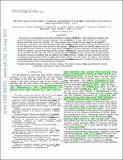The Most Metal-Poor Stars. II. Chemical Abundances of 190 Metal-Poor Stars Including 10 New Stars With [Fe/H] ≤ -3.5
Author(s)
Frebel, Anna L.; Yong, David; Bessell, M. S.; Christlieb, N.; Asplund, M.; Beers, Timothy C.; Barklem, P. S.; Ryan, S. G.; Norris, John E.; ... Show more Show less
DownloadFrebel_The most 2.pdf (5.135Mb)
OPEN_ACCESS_POLICY
Open Access Policy
Creative Commons Attribution-Noncommercial-Share Alike
Terms of use
Metadata
Show full item recordAbstract
We present a homogeneous chemical abundance analysis of 16 elements in 190 metal-poor Galactic halo stars (38 program and 152 literature objects). The sample includes 171 stars with [Fe/H] ≤ –2.5, of which 86 are extremely metal poor, [Fe/H] ≤ –3.0. Our program stars include 10 new objects with [Fe/H] ≤ –3.5. We identify a sample of "normal" metal-poor stars and measure the trends between [X/Fe] and [Fe/H], as well as the dispersion about the mean trend for this sample. Using this mean trend, we identify objects that are chemically peculiar relative to "normal" stars at the same metallicity. These chemically unusual stars include CEMP-no objects, one star with high [Si/Fe], another with high [Ba/Sr], and one with unusually low [X/Fe] for all elements heavier than Na. The Sr and Ba abundances indicate that there may be two nucleosynthetic processes at lowest metallicity that are distinct from the main r-process. Finally, for many elements, we find a significant trend between [X/Fe] versus T eff, which likely reflects non-LTE and/or three-dimensional effects. Such trends demonstrate that care must be exercised when using abundance measurements in metal-poor stars to constrain chemical evolution and/or nucleosynthesis predictions.
Date issued
2012-12Department
Massachusetts Institute of Technology. Department of PhysicsJournal
Astrophysical Journal
Publisher
IOP Publishing
Citation
Yong, David et al. “The Most Metal-Poor Stars. II. Chemical Abundances of 190 Metal-Poor Stars Including 10 New Stars With [Fe/H] ≤ -3.5” The Astrophysical Journal 762.1 (2013): 26.
Version: Author's final manuscript